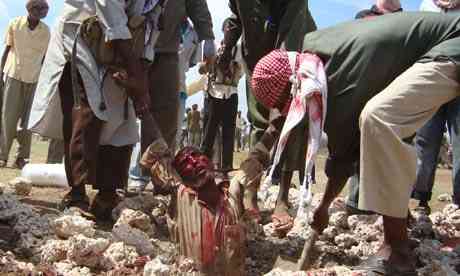
Farah Abdi Warsameh"s Stoned to Death, Somalia, thirteen December. Photograph: AP
"To catch a genocide essentially function and mummify it for all time is something usually cameras can do," writes Susan Sontag in Regarding the Pain of Others, "and cinema taken out in the margin of the impulse of (or usually before) genocide are in between the majority distinguished and mostly reproduced of fight photographs."
Sontag goes on to report the context in that Eddie Adams took what was arguably the majority intolerable design of the Vietnam war: the impulse in that a South Vietnamese military military officer executes a Vietcong think by sharpened him point-blank in the head. She points out that the design was both accurate and staged – "by General Loan, who had led the prisoner, hands scored equally at the back of his back, out to the transport where reporters had gathered. He would not have carried out the outline execution there had they not been accessible to declare it". Wearily, Sontag concludes that "one can gawk at these faces for a prolonged time and not come to the finish of the mystery, and the indecency, of such co-spectatorship".
I was reminded of that last selection when, a couple of weeks ago, I navigated the winner"s art studio of the World Press Photo of the Year website. There, amidst the majority thespian images of conflict, genocide and destruction, was a array by an Associated Press photographer, Farah Abdl Warsameh, entitled Stoned to Death, Somalia, thirteen December. The 4 images are intolerable in a approach that even the majority striking fight reportage occasionally is any more. The initial shows the plant being buried up to his neck in earth. The second shows a organisation of men, their faces secluded by headscarves, raining rocks down on his head. The third shows his bloodied torso being dragged out of the soil. The last shows the men hurling large rocks at his disposed and routine physique to finish off their hideous ritual. There are no captions; we are left to theory the context.
One"s evident instinct on entrance on the photographs is to boomerang in horror, that is what roughly everybody I showed them to did. A co-worker described them as "a kind of publishing of suffering". (The Sunday Times ran the array last week in their Spectrum territory clinging to the World Press awards. Many readers were angry and appalled.)
Last week, in a blogpost for Foto8 magazine, the maestro design editor, Colin Jacobson, wrote that "the rather outrageous cinema … lifted a little engaging reliable matters", that is one – rather understated – approach of putting it. More problematically, Jacobson pronounced that "obviously there was partnership in between the photographer and those carrying out this hideous genocide sentence". Perhaps. But what kind of collaboration? Unlike the sharpened of the Vietcong suspect, the awful execution of the Somalian man would clearly have left forward at that time had the photographer not been present. (Other images from the series, not enclosed in the World Press selection, show an assembly of villagers who had collected to declare the execution.) On that level, the photographer did not combine with the killers, though he roughly positively gained accede from someone to fire the stoning. He additionally shot each theatre of the murdering in all the long and torturous barbarity. What it takes to do that, and at what personal cost, usually he can say.
Images as ardent as these desire so majority questions about the probity of reportage. Did the photographer, one wonders, have any information exchnage with the plant in the time heading up to the event? Would the greeting to the photographs be opposite if we knew that the cursed man postulated the photographer accede to bear declare to his awful death? Would it be opposite if we knew that the photographer risked his own hold up to transport though strife-torn Somalia to bear witness, which, as one of the respondents to Jacobson"s blog points out, was probably the case. Does such ascendancy lessen us or illuminate us? Or simply shock us in to a kind of ardent helplessness?
Part of the formidable energy of these photographs comes from what Sontag calls the "provocation" fundamental in all images of genuine suffering. The initial of majority questions they ask is: "Can you see at this?" Perhaps Sontag comes closest to articulating the dignified quandary at the heart of ardent images of pang when she writes: "There is contrition as well as shock in seeking at the close-up of a genuine horror. Perhaps the usually people with the right to see at images of pang of this ardent sequence are those who could do something to assuage it … or those who could sense from it. The rest of us are voyeurs, either or not we meant to be."
Now see thisNigeria is the sixth largest writer of oil in the universe and one of the main suppliers to America. Subtitled 50 Years of Oil in the Niger Delta, Ed Kashi"s exhibition, Curse of the Black Gold, chronicles the long-term human and environmental cost of oil exploitation in west Africa. You can see this staggering work of reportage at
No comments:
Post a Comment